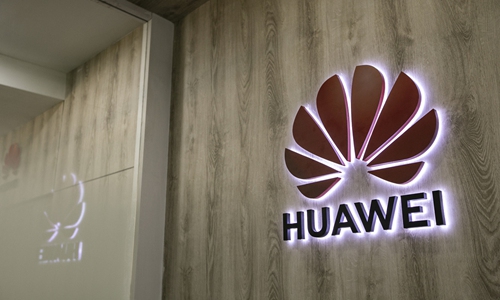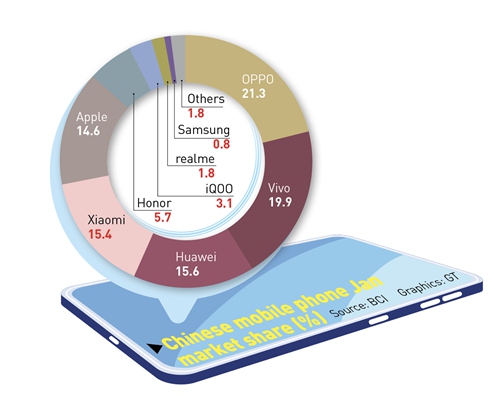
Huawei Photo: VCG
Huawei's mobile phone market share fell to third place in China for the first time in January, according to an industry analysis. Analysts said the decline should be attributed to a lack of chips, but they disagree on how long it will take Huawei to develop and manufacture its own chips.Market research firm BCI announced figures for the domestic mobile phone market in January on Sunday, which showed that Oppo accounted for more than 20 percent of China's mobile phone market, ranking first for five consecutive weeks. Vivo was a close second with 19.9 percent, while Huawei ranked third, followed by Xiaomi and Apple.
Oppo and Vivo have become the biggest beneficiaries of Huawei's market share slide, the report showed. Data from IDC showed that Huawei was the champion in China in 2020 with a market share of 38.3 percent, while Vivo took 17.7 percent and Oppo took 17.4 percent. Although Huawei was still No.1, its share continued to drop after the US government's supplies cut-off.

"It is possibly Huawei's toughest time as it is straining to serve its home market," said Canalys mobility analyst Nicole Peng in January.
Other analysts said it was normal for Huawei's market share to fall, as Honor became independent and chip supplies were limited.
"At present, Huawei's stockpiled chips can last about half a year. If there is no turnaround in chip supply by then, smartphones bearing the Huawei brand will have to exit the market," Zhang Xiaorong, director of the Cutting-Edge Technology Research Institute, told the Global Times on Sunday.
Zhang said it may take Huawei five to eight years to master the technology for 5-nanometer chips that are currently used in mobile phones.
But Ma Jihua, a veteran industry analyst, was more optimistic. "With China's experience, it will be no problem to crack major semiconductor manufacturing technologies within two years," Ma told the Global Times on Sunday.
According to media reports, China has set technology self-reliance as a goal and plans to have 70 percent of its chipsets made domestically by 2025. Meanwhile, China's imports of semiconductor manufacturing equipment increased by 29.8 percent year-on-year in 2020, and integrated circuits by 22.1 percent, customs data showed.
Huawei must solve the chip problem, analysts said.The US ban will be lifted as soon as Huawei announces its own production schedule. If the US and those chip companies realize that Huawei can produce its own chips, they will quickly end the blockade. Otherwise China will become self-sufficient instead of pursuing procurement from US companies, Ma added.
While the semiconductor supply is still up in the air, analysts said Huawei may focus on other technology fields to work out state-of-the-art communications technology breakthroughs.
Zhang said that Huawei is likely to make a big push in the smart car market. The company has been a service provider of intelligent vehicle solution systems or Internet of Vehicles, and it has worked in close cooperation with several domestic automakers.
"Industry insiders have said that Huawei is possibly developing the integrated device manufacture mode for chips. It needs money to continue to spending on fundamental research and development. But Huawei lacks both time and capital, and selling Honor was a good way to raise cash," said Yang Bo, a senior engineer of telecommunications industry.
The Link LonkFebruary 07, 2021 at 08:23PM
https://ift.tt/2YWdYId
Huawei loses market share amid chip squeeze - Global Times
https://ift.tt/3eIwkCL
Huawei
No comments:
Post a Comment